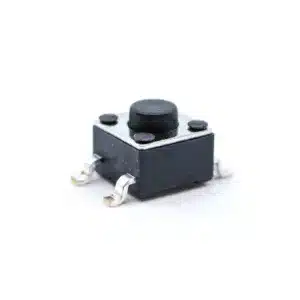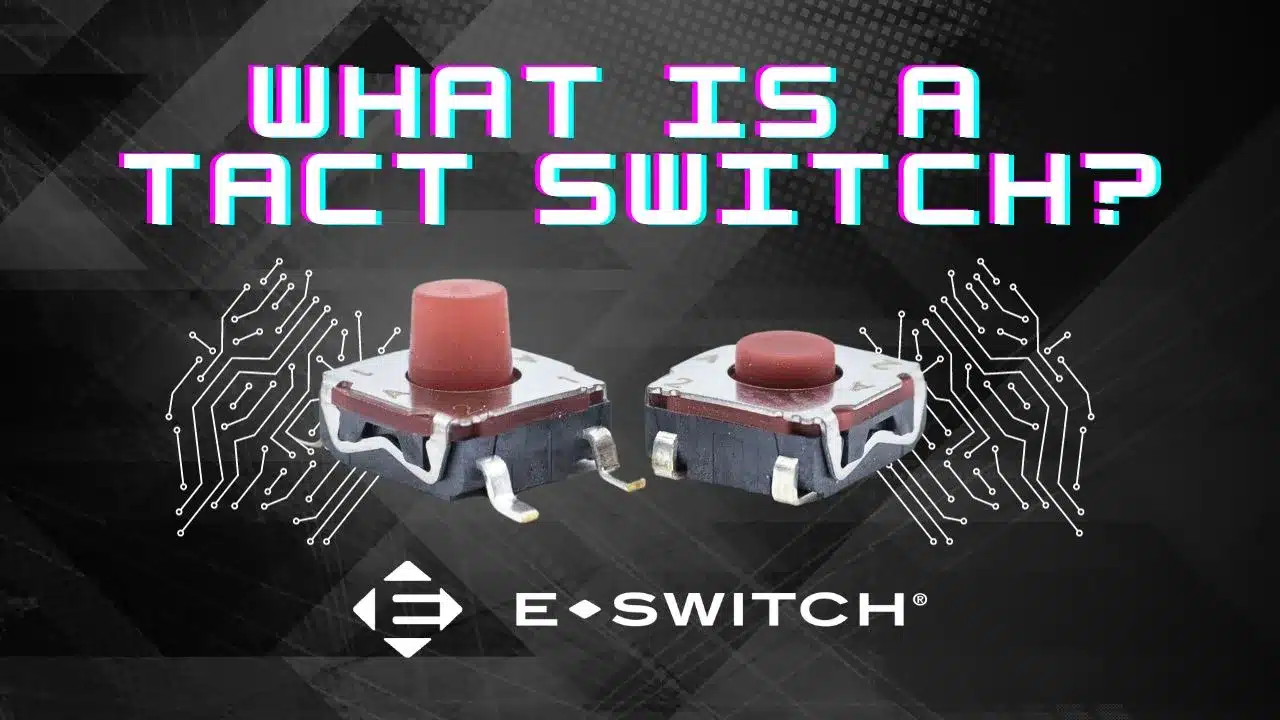What Is A Tact Switch?
Tactile, also known as tact, switches are used to close an electrical circuit when pressed. They are a type of momentary switch designed to be used in electronic circuits and devices to provide tactile feedback to the user when pressed. The definition of tactile is “perceptible by touch; tangible” and tact switches are specifically designed to be perceived by touch.
How Does A Tact Switch Function?

Tact switches close an electrical circuit when pressed. When the switch is released, it opens the circuit. When you press a tactile switch, it provides a physical click or tactile feedback, letting you know that the switch has been actuated. This feedback is particularly important in applications where users need to feel that a button press has been registered (think remote controls and keyboards).
Tactile switches are designed for momentary action, meaning that they only make electrical contact while the button is pressed. When you release the button, the electrical connection is broken. If you want an alternate (latching and maintained) action, then you’re likely looking for a pushbutton switch.
They come in surface mount (SMT) or through-hole versions with some right-angle options, allowing them to be integrated into various types of printed circuit boards (PCBs). Several tact switches have very low profiles, from 0.35mm – 0.65mm and up.
Tactile switches are commonly used as user interface elements for selecting options, entering data or triggering various functions in electronic devices. They are a fundamental component in many electronic products, providing a reliable and user-friendly way to interact with the device.
Pros & Cons
Tactile switches are generally small, compact and have a low profile, making them suitable for use in space-constrained devices. Their compact size, reliability and long operation life makes them ideal for the growing market of wearable technology and handheld devices.
Some things to keep in mind with tact switches are that they are generally designed for low-current, low-voltage applications. They are also designed for noisy operation, giving an audible click or tactile feedback, and that can be a disadvantage in certain applications where quiet operation is preferred. Tact switches also have a sensitivity to environmental factors and a finite number of actuations before they wear out or fail. Some applications call for even smaller switches, so engineers and designers need to carefully consider the specific requirements of their project and whether the advantages of tact switches outweigh their limitations.
What Are Tact Switches Used In?
- Consumer Electronics: They’re found in various consumer electronics, including remote controls, gaming controllers, smartphones, tablets, digital cameras and audio equipment. They’re often used for functions such as power on/off, volume control and menu navigation.
- Computer Keyboards: Many computer keyboards, especially those in laptops and compact keyboards, use tact switches for the individual keys. These switches provide the tactile feedback and actuation required for typing.
- Calculators: Tact switches are commonly used in calculator keypads, enabling users to input numbers and perform mathematical operations.
- Remote Controls: The buttons on remote controls for televisions, DVD players and other entertainment devices often utilize tact switches to control functions and change channels.
- Industrial Control Panels: In industrial settings, they’re used in control panels for machinery and equipment, allowing operators to interact with and control various processes.
- Automotive Controls: They’re found in car dashboards and steering wheel controls, enabling drivers to adjust settings for features like audio, cruise control and navigation.
- Medical Devices: They’re used in various medical equipment and devices, including patient monitoring systems and diagnostic instruments.
- Security Systems: Security system keypads and alarm panels use tact switches for arming/disarming and entering security codes.
- Gaming Consoles: Tactile switches are integral to the buttons on gaming consoles, providing the necessary feedback for gaming interactions.
- Household Appliances: Some household appliances, such as microwave ovens, use tact switches for setting cooking times and temperatures.
- Industrial Machinery: Tact switches are employed in industrial machinery and control systems to facilitate user input for operating and configuring equipment.
- Telecommunication Devices: They’re used in landline phones, mobile phones and communication equipment for dialing numbers and accessing menu options.
E-Switch Tactile Offerings
E-Switch offers tact switches from miniature to 12.4mm square in size and numerous styles — illuminated, non-illuminated, some offer caps, round, square, rectangle and oval. Our tact switch line offers a wide variety of dimensions, profiles, actuation heights and styles from surface mount, right angle and illuminated. E-Switch provides a wide range of miniature switches to fit nearly any compact product developed for the wearable and handheld technology market.
